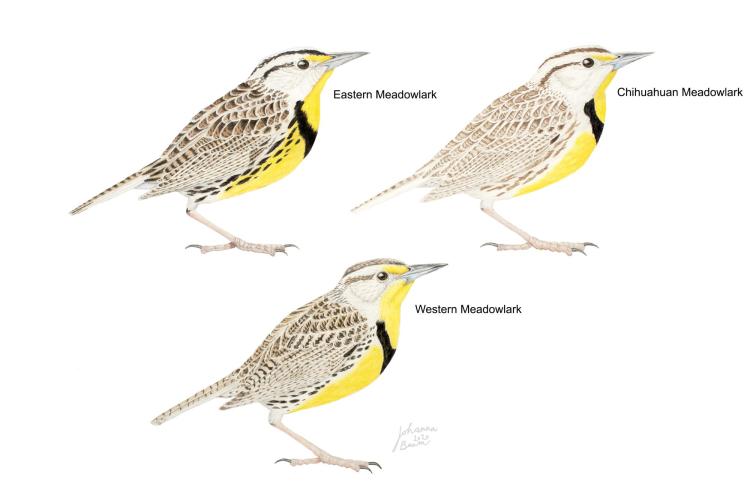Meet the Chihuahuan Meadowlark
Former undergraduate's honors thesis leads to the official recognition of the Chihuahuan Meadowlark as a distinct species
Johanna Beam’s wildlife sketches note subtle variations in color and features that make her subjects distinct. That knack for noticing details inspired an undergraduate research project at the University of Colorado Boulder that recently led the American Ornithological Society to recently recognize the Lilian’s Meadowlark as a distinct species and to change its name to the Chihuahuan Meadowlark.
“A critical component of my science was to always have art,” says Beam (EBio’20). “I look more in-depth when I’m drawing or illustrating a bird. I try to find the features that make birds different.”
Beam’s findings could affect conservation efforts in the U.S. Southwest by making the meadowlark eligible for protection under the federal Endangered Species Act while also giving bird watchers another species to add to their lists.

At the top of the page: The Lilian’s Meadowlark, now Chihuahuan Meadowlark, in Arizona (Alan Schmierer/Flickr). Above: Johanna Beam's undergraduate thesis helped define the Chihuahuan Meadowlark as a distinct species.
Her passion for observing birds (birding) began while visiting her grandparents in Nebraska. As she learned more about the woodpeckers, American goldfinches and juncos she saw there, she wanted to find new birds. This became a game of potential discovery each time she went outside.
“Birding sometimes feels like gambling,” says Beam. “You don’t know what you’re going to get, but the excitement of the possibility of a big win, like finding a big rarity or seeing a bird I’ve never seen before, is addicting.”
A meadowlark who looked and acted weird.
It was that passion for birding that brought Beam to McIntosh Lake in Longmont, Colorado, in 2015 as a highschooler. While there, she noticed a meadowlark that looked and behaved slightly differently from other meadowlarks she’d observed.
“I thought, ‘this meadowlark looks weird. It doesn’t look like a Western—it’s kind of pale, it has a lot of white in the tail, and it never sang,’” notes Beam. “Song for meadowlarks is usually really good for ID.”
She took a photograph and posted it on a birding forum. A commenter noted it looked like a subspecies of the Eastern Meadowlark called the Lilian’s Meadowlark, although it was outside of its traditional range.
“That’s, as of now, the furthest north sighting of this species of meadowlark,” comments Beam.
At that time, Lilian’s was considered a “subspecies” of meadowlark instead of a standalone species and Beam began to wonder why. When a friend emailed a paper that argued the Lilian’s was a full species, but they needed more data to confirm the hypothesis, Beam decided she wanted to do that work.
“Part of it was selfish, but most of my interest was the pure pursuit of knowledge: why is this type of meadowlark different and why is it not accepted as a species? How is it different? How do we figure this out?” says Beam. “That was my first foot in the door to learning about bird genetics and speciation more generally.”
Transforming a sighting into a research project
It was that interest that brought Beam to CU Boulder to work in Scott Taylor’s lab. Taylor, an associate professor of ecology and evolutionary biology and the director of the Mountain Research Station, researches bird genomics and population differentiation.
“Johanna came with, basically, a fully formed project,” reflects Taylor. “She was very well versed in the kinds of questions that birders are interested in, like how many species of birds are there, how do we tell them apart, how can we use song and genetics to help clarify your understanding of avian biodiversity? Knowing that she wanted to work in population genetics as a sophomore is pretty impressive and rare.”
Birding sometimes feels like gambling. ... You don’t know what you’re going to get, but the excitement of the possibility of a big win, like finding a big rarity or seeing a bird I’ve never seen before, is addicting.
She spent considerable time in the Taylor Lab learning new research techniques, processing samples and coding analyses. During that time, Beam also continued to work towards that goal of confirming Lilian’s Meadowlark was its own species by gathering data from previously collected samples of the then-subspecies and her own field work in Arizona. Finally, while she was sitting in her honors class waiting for instruction to begin, she ran the data through a phylogenetic tree, or the diagram that shows how species are related to each other.
“I remember having that graph pop up and I thought, ‘Oh my God. They’re different. And it’s as clear as day!’ It was all I could do to not run out of class,” says Beam. “It was five or six years of wanting to know an answer, and the answer was finally yes. They’re distinct species.”
How recognition of the Chihuahuan Meadowlark affects conservation
Beam conducted several more analyses to confirm the results and found that the Lilian’s Meadowlark’s genetic code predates the Eastern and Western Meadowlarks’ split, meaning its genetic code is older.
She completed her study as an honors thesis at CU Boulder and published her paper in Ornithology. She then submitted a proposal to officially split the meadowlark species, which was accepted by the North American Classification Committee (NACC).
Beam also submitted a renaming proposal to the NACC that shifted the species’ name away from honorifics like Lilian’s and instead focused on the bird’s features, habitat or territory. The committee selected “Chihuahuan Meadowlark” as its new name because it describes the most common habitat area covered by this species. They officially announced the name change on Aug. 3, 2022.
Taylor is quick to point out the significance of an undergraduate’s conducting such meaningful research that adds new knowledge and reshapes the way people experience the world.

The different Meadowlark species (Johanna Beam).
“It's really cool to me that (Beam’s research) was an undergraduate honors thesis, a published paper that gained quite a bit of press, and now is leading to a better understanding of North American avian biodiversity,” says Taylor.
Now that it is officially recognized as a distinct species, the Chihuahuan Meadowlark can be protected under the Endangered Species Act. Subspecies are ineligible for protection. This change comes at a significant time, Taylor says, because Chihuahuan Meadowlarks’ traditional habitat in the U.S. Southwest is suffering an unprecedented drought.
“From a conservation perspective, it's really important to know how many distinct evolutionary lineages there are on the landscape, if you want to preserve the potential of populations to evolve in the face of rapid change,” Taylor comments. “From a broader perspective, it's really important to know what's out there. It's cool that, even now, we can use new tools to discover that there's more variation on the landscape than we thought.”
After Beam graduated in 2020, she was accepted into Penn State University’s PhD program, where she works in the Toews Lab studying the intersection of genomics, bioacoustics, biogeography and their collective effect on bird hybridization. For Beam, adding complexity to the collective understanding of speciation only makes the game of discovering new bird varieties that much more exciting.
“I would hope that (my research) makes people a little more careful when they see a meadowlark and that they will ask ‘which one is this now?’ They have to pay a little more attention,’” she says.
Beam has turned her academic research to other species of birds, but she continues to read about further variation among meadowlarks, such as a potential subspecies of the Eastern in South America, island speciation and species of meadowlarks that live side by side without intermixing. Each observation is a new question, filled with the potential to discover more.
“One tiny door closed, and one question was answered,” says Beam. “But the more I think about it, the more questions I have.”

